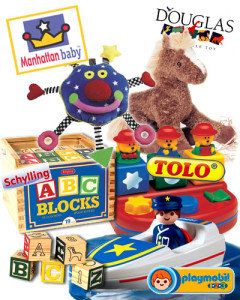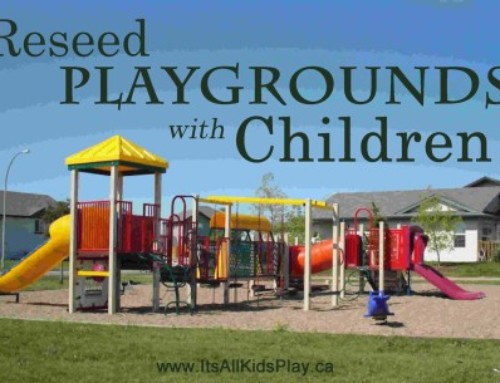It used to be that baby toys were things like rattles and blocks that they could actually use to have fun with. Of course, this meant that babies really didn’t have toys at first because the motion of grasping a rattle or holding a block was well beyond them for the first few months of life. And that was fine – babies did baby things, like sleep, eat, poop, and just stare at the world whilst getting accustomed to it. After all, there’s a heck of a lot in this world to look at, especially when you’re looking for the first time. But time passed and someone decided that we needed toys for newborns. Somehow the world just wasn’t enough anymore. As far as I’m aware, there was no baby convention where they all got together and demanded a new contract, toys included, so I’m guessing this was decided upon by people in the toy marketing departments. I mean, if you can sell X many toys to babies who are three months of age and up, why not tap that untapped market of newborns to 3 months, right?
So we ended up with toys being made for newborns. The problem is that they couldn’t really be ‘toys’ now could they? I mean, newborns can’t really DO much of anything in terms of play. Instead we ended up with toy-like-things that parents place in front of their babies that provide constant stimulation with the briefest of touches (or no touch at all). And best of all, these toy companies have pulled from developmental research and made slight modifications to these toys to make them ‘developmentally appropriate’ or ‘educational’. For example, you get black and white toys that claim to help your baby’s visual acuity. Well, yes, your baby can now see the checkerboard pattern, but is your baby learning anything? No. Will their vision get better faster? No. My favourite claim is the one about the toys teaching cause and effect by, for example, playing music when your child touches it. Um – an inanimate object doing the same thing over and over again is about as helpful to learning cause and effect in the real world as a Water Gun is to fighting a war.
Cause and effect used to be learned via a responsive parent who spends those early months caring for, but also responding to their child. They figure out what baby needs and provide it, whether it be a new diaper, food, or just some comfort – thus baby learns that she can affect the world around her by communicating to those who care for her. When parents become overly reliant on toys, they may actually be teaching the opposite of cause and effect because baby cries for a reason and may be given something completely unrelated to what she needs. The effect is unrelated to the cause. It’s like you going to a restaurant and ordering a Ceasar salad and having the waiter bring you a new pair of sunglasses. Yeah, the glasses may be nice, but you’re going to think your waiter needs to have his head examined.
So, knowing all this, the first question I have to ask is why? What is the point of having something a baby can’t really engage with when he or she could be engaging with the world and really learning what goes on? The fact is, for many parents, letting the toys do the parenting for you is a heck of a lot easier than doing it yourself and so they pick the easy way out. After all, a baby will be kept occupied by toys – it will grab their attention and because it’s go-go-go with these newborn toys, it will also take a baby a while to notice that he or she isn’t being held and that there’s no actual human caring for them. Of course, when they do realize this, that must be one of those horrible moments for a creature whose instinct is to ensure that someone is protecting him at all times. In fact, the toys do nothing but distract; they don’t soothe or anything.
Psychologists at the University of Oregon – Catherine Harmon, Mary Rothbart, and Michael Posner – examined the effects of toys on distracting unhappy 3- and 6-month old babies and found that while the presentation of a toy will grab their attention and allow for periods of calm, as soon as the toys are removed, the infants returned to their previous levels of distress. Thus, the toys don’t actually act as a soother so much as a simple, temporary distraction. The comfort your baby needs isn’t provided at all with toys. Furthermore, research by numerous psychologists (e.g., Fagen, Ohr, Singer, & Fleckenstein, 1987; Wachs & Smitherman, 1985) has found negative relationships between fussiness/negative emotions and ability to focus. Thus, the failure of these toys to provide comfort to a distressed baby means the failure to deal with the negative emotion (thus resulting in a continually fussy baby) which then negatively impacts the baby’s ability to focus.
Second, we have to ask, what are the long-term repercussions of early toy use? I mean, everything we do informs babies of the world around them. You cuddle them, they feel the world is safe. You leave them to cry, they realize the world is a scary place. What message is given to them by these newborn toys? While each individual toy probably doesn’t send a unique message, the gist of these toys seems to be that baby can expect constant stimulation with little to no effort on baby’s behalf. They must be constantly entertained. If a mobile isn’t moving on its own above them, there’s a moving screen with fish dancing around in their bouncy chair, or hanging toys that play music with the slightest of touch. It’s like a constant acid trip for babies. I asked a Kindergarten teacher about this and she told me that she regularly has problems with kids being able to focus in her class. Not that she expects them to sit still and listen – she actually relishes active learning – but that if there isn’t some inanimate object involved (like a cartoon of a butterfly constantly dancing across a screen), these kids don’t pay any attention.
But that’s not the only problem. Implicitly, we’re telling children that these inanimate objects are more interesting and important than both the world around them and human contact. The world doesn’t sing when you touch a leaf, and humans don’t dance if you hit them. Instead, the real world and the humans in it interact in a much more subtle and refined way. Yes, we sometimes go overboard in interacting with babies, but by and large, our interactions between each other and with the world outside are muted compared to what a baby would experience with a toy. This difference is key because babies who grow up on these fast, loud, in-your-face toys can have problems with human interaction later on. People just won’t be as interesting or be able to keep this child’s attention for long periods of time. The same kindergarten teacher who has noticed the attentive problems in her classes also stated that most of her kids were unable to truly connect with the other kids in their class. They had problems understanding the emotions and intentions of their peers and were awful at conflict management, and they didn’t seem to care. Is this really want we want for our kids?
So what are we to do? Well-intentioned people give toys as gifts at showers. Mom needs to take a shower. The answer is painfully simple. Nothing. Let baby focus on the world around him or her and leave it at that – for millenia, that’s what babies have done, just looked at the world around them. If you need to take a shower and no one is there to hold your baby, put him or her in a baby bouncy chair or bassinet in the bathroom and take a shower. There are TONS of things in the bathroom to look at – your baby will not be bored (he may miss your touch but it won’t be for long). In fact, your baby should end up less fussy and more focused because of it.
Anthropologist Barry Hewlett has done cross-cultural research with infants and found that babies in small, forager groups in Africa, where there are no fancy toys for kids at birth, but who are raised using a more evolutionary parenting model, are much less fussy than their North American counterparts. If you’ve seen the movie Babies then you can pretty much see that up on screen; both the African and Mongolian babies were by far the happiest yet there was not a single toy to be found. As for those toys you get at the baby shower or right after birth? Just store them up for when your baby is around three months of age and old enough to actually manipulate the toys and utilize them in a useful way. At that stage, you’ll find baby gets very bored with the simple ones and prefers the more complex and interactive ones that allow him or her to actually engage with or manipulate the toy. It’s not that all toys are bad, but they certainly aren’t all created equal. There are some markets that just shouldn’t be tapped for the sake of a profit and now it’s up to us, as parents, to ensure that the newborn market remains toy-free.
References
Fagen JW, Ohr PS, Singer JM, Fleckenstein LK. Infant temperament and subject loss due to crying during operant conditioning. Child Development 1987; 58: 497-504.
Harmon C, Rothbart MK, Posner MI. Distress and attention interactions in early infancy. Motivation and Emotion 1997; 21: 27-43.
Hewlett BS, Lamb ME, Shannon D, Leyendecker B, Scholmerich A. Culture and early infancy among central African foragers and farmers. Developmental Psychology 1998; 34: 653-661.
Wachs TD, Smitherman CH. Infant temperament and subject loos in a habituation procedure. Child Development 1985; 56: 861-867.





Bravo! I never thought of newborn toys as a marketing gimmick, but they are! I realized they were superfluous when my twins “woke up” from their sleepy preemie stage and wanted to look at faces. They really hated having those shiny, obnoxious toys in the way. I understood their cues well enough to take away the distractions, but I worry about how to do that as they get older…
I think as they get older, it’s just allowing them to play with things around the house. Although some toys are good as long as they engage your child and keeps them slightly out of their comfort range (i.e., they learn). But my daughter just loves regular things around the house – books being her favourite, but my wallet, boxes, and random other things qualify as awesome play things as well 🙂
It is amazing though the difference when children are allowed to explore their surroundings and people without being overstimulated with toys. It seems they can learn so much more about others and themselves when there are no superficial distractions!
🙂
Even at 1 I don’t allow “toys” that just entertain. A good toy is kid operated, not battery operated, simple and made of natural materials in my opinion. I’m reading an learning a lot about play and how vital it is. I see so many babies and small children whose toys are all just push a button to hear a song. It’s kind of sad.
I think that any and all toys can be great if used correctly. The problem with them only exists when they are used as a babysitter. My son was given a mobile by my MIL when he was 5 weeks old and he LOVED it. He would lie under it and call out for the music to start and when it did he would run and dance (insomuch as one can run and dance while on their back) and squeal with excitement. But I didn’t let him alone at it, the mobile was attached to his-cosleeper and when he would lie under it, I would lie next to him and we would talk and I would tell him stories about the animals, talk about what he was seeing and do silly dances and songs to the music. It was a fun time for us. Now at 10 months he has a much maligned ‘press the buttons make music’ toy that he enjoys while on the potty. But again it’s a game we play together. He presses the frog I do a funny dance, he presses a number I sing a counting song, etc. Maybe I’m just very unusual but the toys that get slated as being mainly used as a babysitter are things that in our house require more attention from me. If he is happily chasing a wooden block about the floor or banging the dog bowls together, that tends to be his own time and he looks for very little interaction from me. If he is playing with a noisy, battery operated, bells and whistles type toy, then he is doing something where he wants and get my full attention and participation.
[…] Taking the newborn out of newborn toys […]
Excuse me…Are you suggesting that by giving my baby toys that I’m lazy and taking the “easy way out”??????????????? What is wrong with you??? I also don’t think that “asking” a teacher about her class is a very scientific argument. You’re implying that toys are causing lack of attention without any evidence or real research…One teachers opinion does is not truth. This article is garabage and just aims to make parents who give their babies toys feel bad. Don’t you have a PHD? Shouldn’t you know the difference between evidence and opinion. Shame on you for not being better at research and science!
I’m sorry this seems to be so triggering for you. You are obviously welcome to give your newborn (which really covers the first 3 months, as mentioned in the piece – I don’t know how old your baby is) toys and to discount anything written in that article. Is there something in there that you are particularly bothered by? The idea that newborns do not benefit from toys is not unique to me and we are learning more and more about how many “educational” toys are not what we thought they were, especially electronic ones which are geared towards young babies who cannot manipulate other toys. Using an anecdote to discuss it does not mean it’s conclusive science and I never claimed it was, but anecdotes are what often lead to new research 🙂
Now, toys can be wonderful – especially as children age. Just remember: This is about newborns. And even more so, you don’t need to agree 🙂
[…] Taking the Newborn out of Newborn Toys – Tracey Cassells (Evolutionary Parenting) […]
This is something I’ve noticed with my baby even into her 13th month. She wants to ‘play’ with everyday objects around the house. The one time I do utilize toys as a distraction is in the car, as she hates the car. I used to pull over MANY times even in a few miles as I couldn’t not console her crying and I didn’t have anywhere I needed to be, but with my child. Sometimes though I couldn’t stop (freeway) and I would use toys to at least distract her all the while talking to her and doing my best to empathize with her until I could stop. Now I play simple songs that she seems to love and has even learned to say duck and quack from them. Do you have suggestions about when toys actually become important? As I still don’t seem to see her caring much (I leave out blocks and stacking things etc. I’m case they should interest her.
You could always leave stuff out and she’ll become engaged when she’s ready to manipulate them. But often they want to mimic us so having kid stuff around like yours is all she needs 🙂
My baby just discovered his first toy at two months, which I wasn’t expecting, given that my husband and I have a strict “baby operated, not battery operated” rule for toys. He’s only beginning to use his hands at all.
It’s this dinky, simple, stationary mobile above his pack and play. Just a few puffy clouds and a star hanging down. They definitely look like vague blobs from his angle. But he discovered that if he wiggles enough, the hanging blobs move (because pack and plays can shake pretty easily). So he’s been staring at them intently while moving his arms and legs wildly. It’s really interesting to watch.